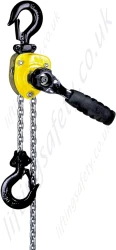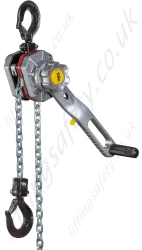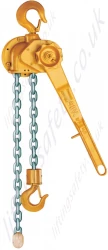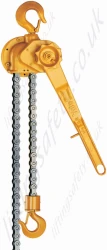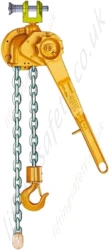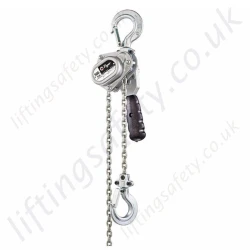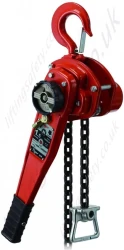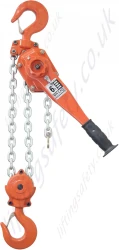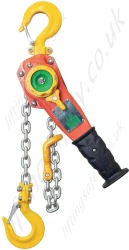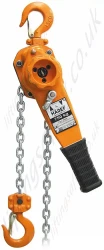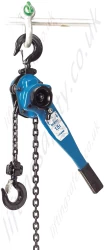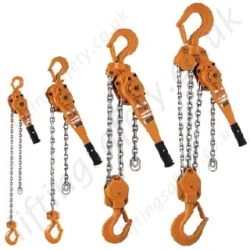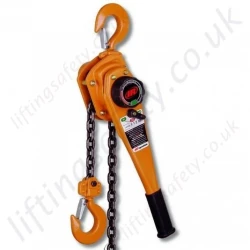
Lever Hoists
A lever hoist is a hand-powered type of manual chain hoist that is operated by a lever action, rather than pulling a hand chain like you see on a manual chain block. Lever hoists are also known within the industry as pull lifts (or Pul-Lift) because they often serve as a dual-purpose machine in that they are not only used to lift a load, but they are also commonly used to pull, separate, tension and hold a load.
A lever hoist is a very versatile piece of lifting equipment and is often preferred over a manual chain block because of the ease in quickly altering the hook position (when not under load), with the free-wheel function that is unique to the lever hoist.
Within our range, you can find ratchet lever hoists from the likes of Yale, Tiger Lifting, Kito, Hackett, Tractel, Pfaff and Hadef, among others, all with this as a standard feature.
Our lever hoists are made from many different materials, such as a pressed steel body, a cast iron body or an aluminium construction, and we offer you a great choice online in the hope that we will have at least one lever hoist from the manufacturers mentioned above that will suit your lifting or pulling needs.
As standard, most of the lever hoists that we offer have a 1.5 metre lift height (the odd 1 or 2 are supplied with a 3 metre standard lift height), but, on all models, the height of lift or chain length can be tailored to your requirements.
Within the range, we also offer lever hoists with special key features, such as Atex protection and/or corrosion-resistant units that have been specifically designed for subsea and offshore use.
Please do not hesitate to contact us if you need any assistance or advice in choosing the most appropriate option.
Lever Hoist Brands
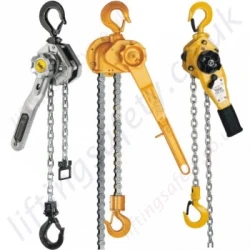
Yale Lever Hoists
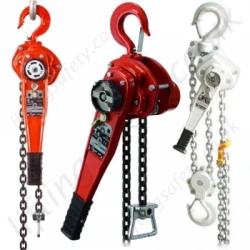
Tiger Lever Hoists
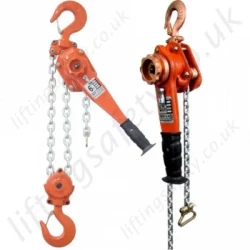
William Hackett Lever Hoists

Hadef Lever Hoists
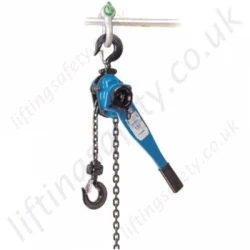
Tractel Lever Hoists
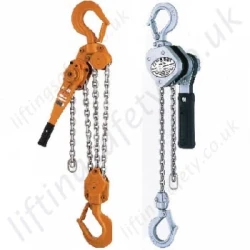
Kito Lever Hoists
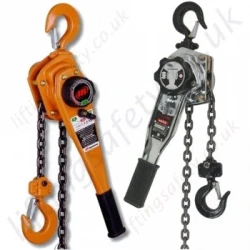
Ingersoll Rand Lever Hoists
All Lever Hoists
More About Our Lever Hoist Range
With our comprehensive range, we offer a wide selection of lever hoists that are built to a high-quality standard from different manufacturers, like Yale and Tiger.
Amongst the different features that we have to offer are lightweight aluminium-bodied units and a selection of different heavy-duty options, some made from cast iron or lever hoists with a very fine ratchet mechanism for precise controlled movement.
We also have a range that is corrosion-resistant to the level that they are designed for subsea underwater use, which can be supplied with zinc-plated, corrosion-resistant, or stainless steel load chains. In addition to this, the end terminations (standard latch load hooks) can also be replaced by the likes of self-locking hooks, clevis shackles, or egg links.
Contact our sales or technical department if you need any assistance or further information to enable the right choice to be made when selecting the most appropriate hoist for your application.
Ratchet lever hoists are a really convenient piece of portable lifting equipment that can be quickly and easily set up, and they can be used in most environments, indoor and outdoor use, in a workshop or on an offshore oil platform, etc.
Our lever hoists can be supplied in capacities from 250kg right up to a 20-tonne SWL, and are the ideal solution where portability, ease of use (they are a very easy-to-use lifting tool that requires minimal training), cost-effectiveness, lack of electrical power supply, and durability are a requirement.
Lever Hoist Uses
A lever hoist is a lifting, pulling, and tensioning device. A ratchet mechanism pulls the load chain through the hoist body, shortening the distance between the load hooks. The lever action of the handle reduces the manual effort required to operate the hoist. Every unit has a maximum safe working load, and this should never be exceeded.
Lever hoists are rated as a vertical lift, but they can be used for tensioning at angles, though the load must be calculated by the competent person to ensure that the hoist is not overloaded. In instances such as this, it is deemed good practice to have a load measuring device in-line (the likes of a load cell) to monitor the load as tension is applied.
When pulling a load, such things to consider the following:
- Is the load rolling (on wheels)?
- Is the load on a level flat surface or on a slope?
- Is the surface smooth concrete?
- Are you pulling through sand? Etc.
To summarise, the maximum load that can be pulled is dependent on user assessment, taking into account the amount of drag/resistance.
Where did the term Pul-Lift come from?
Originally, the term Pul-Lift came to life with the invention of the Yale D85 and C85 as early as 1936. To date, over 1 million original Yale Pul-lifts have been sold.
As mentioned earlier, a lever hoist is often used for both pulling and lifting, hence the term Pul-Lift.
Lever Hoist vs Chain Hoist
You'd choose a lever hoist over a for jobs that require portability, versatility, and precision in tight spaces. While both are manual lifting devices, they differ significantly in their operation and ideal applications. The key differences lie in their lifting direction, mechanism, and overall design.
When to Choose a Lever Hoist Instead of a Chain Block
A lever hoist, also known as a lever chain hoist or lever lift, is the superior choice for a number of specific scenarios. Its compact design and unique operating mechanism make it ideal for tasks that a hand chain hoist can't handle as effectively.
- Versatile Lifting and Pulling: A lever hoist can lift, pull, and position loads in multiple directions - vertically, horizontally, and at angles. This is its primary advantage. Hand chain hoists are almost exclusively designed for vertical lifting.
- Work in Confined Spaces: The compact nature and side-mounted lever of a lever hoist mean you don't need a lot of overhead room. You can operate it from the side of the load, which is a huge benefit in tight quarters or when working with low ceilings.
- Precision and Control: The ratcheting mechanism of a lever hoist allows for very small, incremental movements. This is perfect for tasks that require fine-tuning the position of a load, such as aligning pipes or fitting beams.
- Portability and Mobility: Lever hoists are lightweight and easy to carry from one job site to another. This makes them the go-to tool for field work, construction, and rigging where you need to move the hoist frequently.
- Tensioning and Securing: Because of their ability to pull horizontally, lever hoists are excellent for applying tension to cables, ropes, or chains to secure loads or prepare equipment.
When to Choose a Hand Chain Hoist Instead of a Lever Hoist
A hand chain hoist (also called a chain block) is better suited for other tasks, primarily those that involve heavy, repetitive, and stationary lifting.
- Heavy Vertical Lifting: Hand chain hoists are designed to lift very heavy loads straight up and down. They typically have a higher lifting capacity than lever hoists.
- Fixed-Location Applications: These hoists are often mounted to a trolley, beam, or other fixed structure. This makes them ideal for repetitive lifting in a workshop, warehouse, or factory setting where the hoist remains in one location.
- Operating from a Distance: Since a hand chain hoist is operated by pulling a long chain, you can stand on the ground and lift a load that is positioned high overhead. This is not possible with a lever hoist, which requires you to be close to the hoist to operate the lever.


